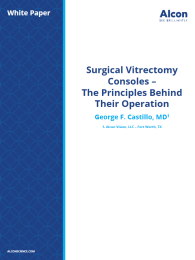

Key Takeaway Points
- Surgical vitrectomy consoles have evolved tremendously and have incorporated the functions necessary for the vitreoretinal surgeon to perform safe and efficient surgery
- Volume flow always results as a consequence of a pressure gradient, and a balance of the inflow path (infusion cannula) with the outflow path (vitrectomy probe). The dynamic material characteristics of ocular tissue (ie vitreous, buffered saline solution, lens fragments, etc.) require precise inflow pressure gradient control
- Intraocular pressure (IOP) can be well-preserved by accounting for resistance (pressure drop) within the inflow circuit
- The stability and adjustability of vitrectomy probe performance at high speeds (> 5000 cuts per minute [CPM]) is best achieved by dual pneumatic driving pressure, controlling both the closing AND opening of the probe cutter
Vitrectomy consoles have evolved tremendously since the advent of vitrectomy cutters. Advancing from a simple rotary motor to pneumatically driven systems and from the evolution of a single- function unit to an integrated system with light sources, fragmentation modules, LASER modules and fluid-air exchange capabilities, today’s vitrectomy consoles are complex systems that allow for safe and efficient ophthalmic procedures.
There are several aspects of vitrectomy consoles that are best addressed separately: 1) how a console addresses volumetric flow in and out of the eye, and 2) the versatility of control that a vitrectomy console has in order to generate the most predictable conditions for a vitrectomy probe to operate safely in proximity to vital structures within the eye.


